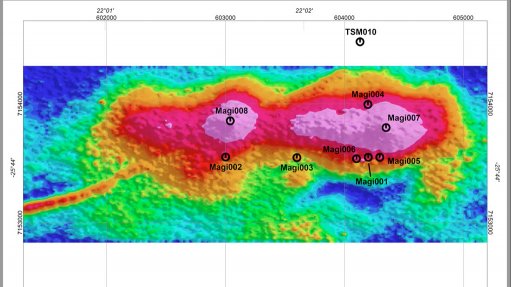
Photo by: Pangolin Diamonds
TORONTO (miningweekly.com) – Toronto-based explorer Pangolin Diamonds on Thursday revealed that it had recovered four more diamonds from the Magi kimberlitic sandy tuff at its Tsabong North project, in south-west Botswana.
The TSX-V-listed company, which was currently exploring for diamonds on four licences in Botswana, reported that CF Mineral Research in Kelowna, Canada, recovered four diamonds from ten samples taken from the Magi target, using a caustic fusion technique.
Drill hole Magi008 targeted a discrete circular magnetic high within the Magi target. The total depth of the drill hole was 121.3 m.
Pangolin also submitted 17 samples of Magi drill core to the Saskatchewan Research Council (SRC) Geoanalytical Laboratories, which returned no diamonds, the company said.
The explorer had, to date, recovered seven diamonds from the target, after reporting that it had recovered three microdiamonds with a total carat weight of 0.000108 ct.
Pangolin noted that further work was planned at Magi to drill holes beyond the 100 m vertical into two separate, discrete circular magnetic targets within the Magi target. Additional geophysical work was also planned, the company said.
Pangolin last year announced that it had discovered what it believed to be one of the largest-ever kimberlite pipes in the world at its Tsabong North project, in Botswana.
The company reported it had modelled the kimberlite at 270 ha, making it comparable with the Se251 kimberlite, in Angola, that measured 220 ha, the MK1 kimberlite, in Botswana, that measured 180 ha and the Mwadui kimberlite, in Tanzania, which measured 146 ha.
Further, Pangolin stated that results of diamond-recovery analysis for 19 samples of the Mmadinare project-SWS21 intrusive drill core submitted to SRC also returned no diamonds.
Groundwork continued at the Mmadinare project where a number of additional targets were being evaluated. A large soil-sampling programme was also being prepared and expected to start in late October following work at the Malatswae project.